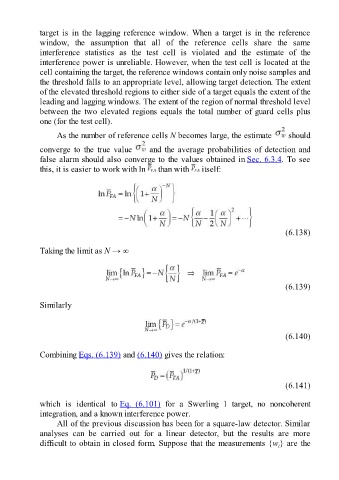Page 506 - Fundamentals of Radar Signal Processing
P. 506
target is in the lagging reference window. When a target is in the reference
window, the assumption that all of the reference cells share the same
interference statistics as the test cell is violated and the estimate of the
interference power is unreliable. However, when the test cell is located at the
cell containing the target, the reference windows contain only noise samples and
the threshold falls to an appropriate level, allowing target detection. The extent
of the elevated threshold regions to either side of a target equals the extent of the
leading and lagging windows. The extent of the region of normal threshold level
between the two elevated regions equals the total number of guard cells plus
one (for the test cell).
As the number of reference cells N becomes large, the estimate should
converge to the true value and the average probabilities of detection and
false alarm should also converge to the values obtained in Sec. 6.3.4. To see
this, it is easier to work with ln than with itself:
(6.138)
Taking the limit as N → ∞
(6.139)
Similarly
(6.140)
Combining Eqs. (6.139) and (6.140) gives the relation:
(6.141)
which is identical to Eq. (6.101) for a Swerling 1 target, no noncoherent
integration, and a known interference power.
All of the previous discussion has been for a square-law detector. Similar
analyses can be carried out for a linear detector, but the results are more
difficult to obtain in closed form. Suppose that the measurements {w} are the
i

